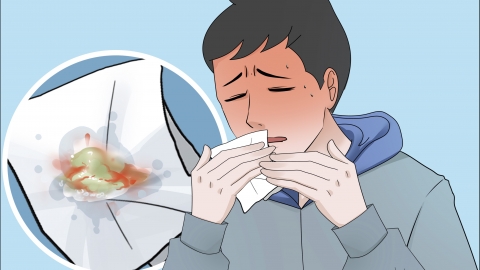Why does pulmonary tuberculosis cause hemoptysis?
Generally, hemoptysis caused by tuberculosis may be due to factors such as lesion erosion of small blood vessels, increased vascular pressure, formation of tuberculous cavities, bronchiectasis, or tuberculous pleurisy. It is recommended to seek timely medical attention, identify the underlying cause, and undergo symptomatic treatment under a physician's guidance. A detailed analysis is as follows:

1. Lesion erosion of small blood vessels: Tuberculosis lesions caused by Mycobacterium tuberculosis destroy lung tissue and erode surrounding small blood vessels, leading to vessel rupture and bleeding, which causes hemoptysis. Hemoptysis is often characterized by blood-streaked sputum or minor bleeding, accompanied by coughing and low-grade fever. Patients should rest in bed, avoid strenuous activity, and follow medical advice to take anti-tuberculosis medications such as isoniazid tablets, rifampicin capsules, and pyrazinamide tablets to control the lesion. Additionally, tranexamic acid tablets may be used for hemostasis, and bleeding usually stops once the lesion is controlled.
2. Increased vascular pressure: Pulmonary inflammation caused by tuberculosis leads to localized vascular congestion and elevated pressure, making fragile blood vessels prone to rupture and bleeding, which causes hemoptysis, often accompanied by chest tightness, fatigue. The volume of bleeding increases when inflammation worsens. Active treatment of tuberculosis is necessary, following medical advice to take ethambutol tablets to enhance anti-tuberculosis effects. Patients should also avoid forceful coughing and emotional excitement to reduce vascular pressure. During bleeding episodes, the patient should lie on the affected side to prevent blood from entering the healthy lung.
3. Formation of tuberculous cavities: Necrosis and liquefaction of tuberculosis lesions lead to cavity formation. The exposed and fragile blood vessels in the cavity walls are prone to rupture when stimulated by coughing, causing moderate to massive hemoptysis, often accompanied by night sweats and weight loss. Patients must remain absolutely bedridden and follow medical advice to use posterior pituitary injection for hemostasis while receiving intensified anti-tuberculosis treatment. If cavities are large or recurrent bleeding occurs, interventional cavity embolization may be required to block the bleeding vessels.
4. Bronchiectasis: Tuberculosis lesions involving the bronchi cause structural destruction of the bronchial walls and subsequent bronchial dilation. The vessel walls of the dilated bronchi become thin and distorted, making them prone to rupture and bleeding, which causes hemoptysis, often accompanied by recurrent coughing and purulent sputum. Patients should follow medical advice to take medications such as isoniazid tablets, rifampicin capsules, and ambroxol hydrochloride oral solution.
5. Tuberculous pleurisy: Tuberculosis spreading to the pleura causes inflammation, and pleural adhesions can pull nearby blood vessels, causing vessel rupture and bleeding. Blood seeping into the bronchi results in hemoptysis, often accompanied by chest pain and difficulty breathing. Patients should follow medical advice to take medications such as pyrazinamide tablets, ethambutol tablets, and prednisone tablets.
In daily life, patients must strictly follow medical advice and adhere to anti-tuberculosis treatment, avoiding self-discontinuation of medication. Regular follow-up with chest CT scans and sputum tests is necessary to monitor lesion changes. Indoor air should be kept well-ventilated, and patients should avoid fatigue and cold exposure. Nutritional intake should be enhanced to improve physical condition, promote healing of pulmonary lesions, and reduce the risk of hemoptysis.




